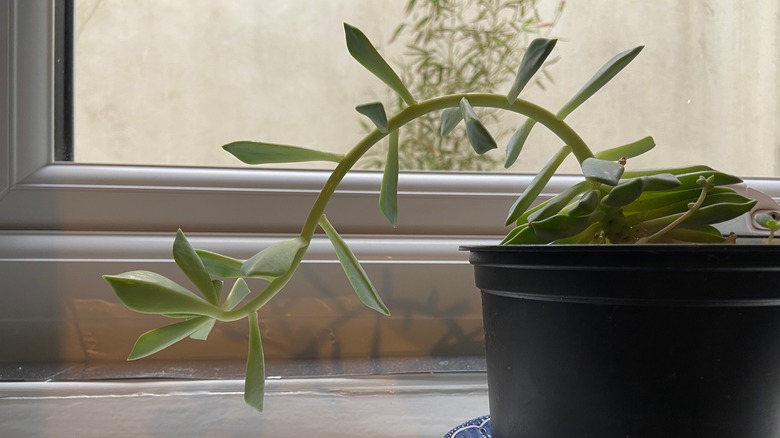Why Houseplants Become Leggy And How To Prevent Or Fix It
Have you ever had a houseplant that was growing tall or long but stayed very thin? Perhaps the stems were mostly bare except for a few straggly leaves at the top, or it just didn't look healthy and flushed out even though it was definitely still alive. The term used when stems become lanky and sparse like this is etiolation, Botanical Bright notes. When left untended, a plant with this problem inevitably turns leggy. Weakened stems will not be able to stay upright, often bending over from the weight of whatever leaves remain.
According to Patch, the most common cause of etiolation in houseplants is a lack of proper light exposure. Plants forced to stretch towards a faraway light source will not be able to handle the situation for long. Sometimes they'll bend towards a window, like the striving succulent pictured above. But, most often, the stems will grow straight up, expecting to find the sun above them just as it would be in nature. Etiolation usually happens to succulents, but it's a problem that any plant can have.
Patch adds that, on occasion, outdoor garden plants will become leggy due to a lack of annual pruning. But when it comes to your indoor potted houseplants, you can depend on the fact that low light is the cause of your issue.
How to prevent legginess in your plants
We've established that legginess is caused by insufficient light, and, as is to be expected, the Garden Answer YouTube channel explains that the single best way to prevent etiolation from even starting is to move your plants into a brighter location or provide grow lights. But how much brighter and for how long? And, wait, aren't there actually different kinds of light?
In their guide to indoor light, Patch takes the basic knowledge — that all plants depend, at least to some extent, on light for survival — quite a few steps further. First, light levels differ with changing seasons; they also change depending on the time of day. Even windows facing different cardinal directions (north, east, west, south) experience varying quantities and degrees of exposure. Then we have direct versus indirect light. Some plants, like cacti, love enormous amounts of hot, intense sunlight — the kind that would give many among us a sunburn; others, such as monkey mask monsteras, not so much. Then we have the ferns and other low-light plants, who don't really need much sunshine at all. Ahh, but they do need some!
This is why houseplants come with care instruction labels sticking out of their soil. Learning about each of your plants' individual requirements allows you to determine the best placement for each within your home, and proper placement means full, happy houseplants that don't need to stretch uncomfortably in search of light and, thus, do not become leggy.
How to fix legginess when it's already happened
Fixing legginess that has already begun to occur is a tougher problem to tackle. Succulents Box says that once etiolation occurs in a succulent, it is a permanent problem, and there's no chance of your plant going back to a normal shape. The best way to help a stretched-out plant is to cut its stems and leaves for propagation. With sharp, clean gardening shears, remove all leggy stems. Next, cut off all of the lower leaves from the removed stems. Leave each piece to dry and callous for 24 to 48 hours. Finally, plant the stem cuttings in pots and care for them as you would any new plant.
Garden Answer explains that once planted, new roots will shoot out of the stem cuttings at each point where a leaf had originally been attached. Another option with a leggy plant is to prune it all the way back to the soil level. Pruning is your way of telling a plant to focus its energy on new growth, and with a little luck, pups will begin to shoot out over time, and the plant will regrow.
Garden Answer suggests using a shallow tray filled with succulent-specific soil to propagate the leaves you initially removed from the stems. Gently lay the leaves on top of the soil. Wait a week before spritzing them with water. After a few weeks, you should see roots starting to grow (via YouTube).


